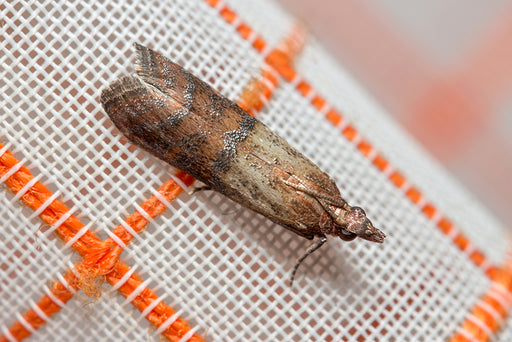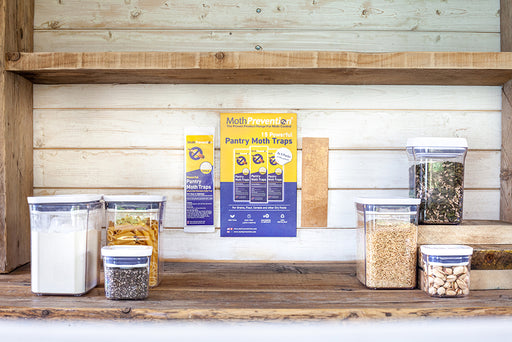All About Pantry Pests And How To Get Rid Of Them

Are you wondering how to get rid of pantry pests quickly? Fair enough. After all, few things are more disturbing than going to get something from your pantry and finding all sorts of creepy crawlies hanging around. Here, we will discuss the different types of pests that get into pantries commonly. Then, we will go over the best pantry pests identification strategies, and in particular, how to get rid of Pantry Moths.
FAQs About Pests and Bugs in the Pantry
So, what are pantry pests, and why are they in your house? Here’s what to know.
What are these little bugs in my pantry?
Pantry pests are nuisances that infest homes looking for food to eat and/or abundant sources of nutrients for their offspring. Once they find an adequate food source, they will either consume it directly or lay eggs that then hatch into larvae which consume the nearby food items. Moths and beetles are the most common insects that infest pantries.
Common Causes of Pantry Pests:
- They can come into a home by hitching a ride on a food item
- Undisturbed pantries attract pantry pests
- Open containers of dry goods are a common nesting place for pantry-infesting insects.
What to Do About Pantry Pests:
- Find out what kind of pests you are dealing with
- Eliminate an infestation at the source
- Take preventative measures to keep pests from returning
What do Pantry Pests eat?
Pantry pests are also referred to as stored product pests. This group of pests has a ravenous appetite for dried foods and processed goods often stored in pantries. Products that pantry pests infest include cereals, pasta, grains, dry pet foods, flours, cornstarch, powdered milk, spices, bread, crackers, dried fruits, bird seed, and more.

What causes pantry pests?
Pantry pests often come into your house through infested items. However, open containers of food can also attract them. For this reason, it is best to store your food items in airtight containers.
Are pantry pests harmful to humans?
The good news is that pantry pests do not usually cause diseases. The only pantry pests known for causing diseases are mice. Indian Meal Moths, Cigarette Beetles, and Sawtooth Beetles do not carry any parasites or harbor diseases. Still, it is best to eliminate an infestation as soon as you notice it.
How long do Pantry Pests stick around?
Depending on how abundant a food source is, pantry pests can stick around for a long time. Since they breed continuously, they thrive in quiet areas where foods are stored. Several generations of pests may be produced in just one year. How long these pests stay will depend on how much food there is for them to eat, when you eliminate the infestation, and if they can return again. The sooner that you eliminate an infestation, the better.
Types of Pantry Pests and Pantry Pest Identification Strategies
There are many different kinds of pantry pests. One of the most common pests to watch for in a pantry is the Indian Meal Moth, or, Pantry Moth. However, there are also certain types of beetles, mice, and other creatures that may invade your pantry.

Sometimes, you will find evidence of pests in your pantry without actually seeing the culprits themselves. It is important to identify what creatures are devouring your stored goods so that you can choose an appropriate extermination strategy. If you are unsure about what your pantry pests look like, use the following information to help you.
Evidence of Indian Meal Moths
Indian Meal Moths are also known as Pantry Moths. Pantry Moth Larvae eat all kinds of dried goods stored in the home. These pests are notorious for being difficult to get rid of and are without question one of the most common types of pantry pests. Scientifically known as Plodia Interpunctella, these small moths have reddish brown and tan wings. When fully grown, the moths can also be coppery-colored or whitish gray with markings on the front half of their bodies.
Pantry Moths lay eggs in pantry goods. The eggs hatch into hungry larvae that look like little worms. The worms eat through all kinds of foods before spinning cocoons and starting the cycle over. The brown or tan larvae of the Indian Meal Moth are responsible for consuming foods and causing damage to your pantry goods. If you see these moths or their larvae, you should eliminate them right away.
Evidence of Pantry Moths can include:
- Cocoon casings in your pantry
- Adult moths in the home
- Webbing along the corners of packages
- Sticky secretions in your dried goods
- Dead adult moths or larvae
Evidence of Sawtoothed Grain Beetles
Sawtoothed Grain Beetles are scientifically known as Oryzaephilus Surinamensis. These beetles are flat, brown, and slender. They measure about one-tenth of an inch long and have serrated, saw-like spikes on the sides of their thoraxes, between their abdomens and heads. The larvae and adults both like to feed on dried foods. Sawtoothed Grain Beetles are scavengers. They eat open products like candies, cereals, nuts, dried fruits, and more. They are even known for infesting birdseed and rodent bait.
Evidence of Sawtoothed Grain Beetles can include:
- Finding adults crawling on surfaces
- Dead beetles on storage shelves
- Small holes in cardboard boxes or food packaging

Evidence of Cigarette Beetles
Cigarette Beetles (Lasioderma Serricorne) measure about 1/8 of an inch long and are light brown in color. They have an oval shape and little hairs that make them look somewhat fuzzy. They are known for eating tobacco from cigars, cigarettes, or dry cured tobacco leaves. These pantry beetles are most commonly found in stored tobacco products, nuts, pet foods, and cereals. However, they may also infest wreaths or even spices like chili powder.
Evidence of Cigarette Beetles can include:
- Debris from packaging scattered on shelves
- Small holes in food packaging
- Dead or alive adult beetles
Evidence of Mice
Finally, we have to mention mice as a pantry pest. Although mice can infest pretty much any part of your house, they are notorious for getting into pantries and cupboards. This is especially true if you have a pantry in a cabin or home where there isn't a lot of activity going on. You probably already know what mice look like! Not all mice are likely to infest your home, however. In North America, three kinds of mice like to come inside houses and snack on your pantry food. These are house mice, white-footed mice, and deer mice. Mice are nocturnal, meaning that they are primarily active at night.
Evidence of mice can include:
- Mouse droppings
- Large holes in the corners of boxes
- Plastic bags that have been gnawed through
- Shredded balls of material in corners of cupboards or near the floorboards
*This article is focused on primarily insect pantry pests, particularly, Pantry Moths. For help getting rid of mice, check out this blog.
Four Common Reasons People Get Pantry Pests
An infestation of bugs in your pantry is not necessarily indicative of a dirty house. So, don’t feel bad if you have Pantry Moths! Even if you keep your house incredibly clean, you could still get these persistent pests. There are a few reasons that insects like to infest pantries and they have little to do with your cleanliness. Here are the most common reasons for pantry pests:
1. Pantry Pests Like to Invade Quiet Places
Inactivity is one of the biggest reasons for the infestation of pantry pests. For instance, if you have items stored in your pantry that you don't pick up or use much, they may attract pests. Rental homes, vacation homes, and cabins are all ideal locations for pantry pests where they can seek out food sources without disturbance.

2. Open Food Attracts Pests
Open items are also likely to attract pantry pests. This could be an open bag of flour, a half-used box of cereal, or even a large bag of dog food.
3. Pantry Pests Might Hitch a Ride
Pantry pests may also get into your home through an unopened item. For example, large bags of bird seed may contain the larvae pantry infesting insects. Pet food, bulk items, flour, and grain bags may also be infested. This is one reason to be careful about buying expired items.
4. Outside Storage May Lead to Pests
If you store food items in a garage, shed, storage unit, or somewhere else that is exposed to the elements, pests may sneak in. For instance, if you have a bag of bird seed on your porch for a few days and then later bring it into your pantry, a Pantry Moth could have laid eggs in it.
Pantry Pests Moths: Everything to Know
Pantry Moths are one of the most common types of pests that infest homes. As such, it is important to know how to identify Pantry Moths. Then, you can start taking measures to eliminate an infestation or prevent one from happening in the first place. As they say, you should always know thy enemy! Here is what you should know about Pantry Moths.
Are Pantry Moths dangerous?
Pantry moths are not dangerous. The biggest problem with these pests is that they can cause food to spoil. This creates a lot of waste and can also be expensive. If you accidentally ingest a Pantry Moth, its eggs or larvae, don't panic. These insects are not known for spreading any diseases and they do not carry any harmful pathogens or parasites. Still, the idea of ingesting Pantry Moth Larvae is pretty disgusting. So, we recommend eliminating them as soon as you notice signs of an infestation.
What causes Pantry Moths?
Pantry Moths can get into your home in many ways. For the most part, they come in through contaminated items. In fact, Pantry Moths can get into your home directly by hitching a ride in a food package from a processing plant. However, Pantry Moths might come in through open doors or windows. They can also get into your pantry through items that were left outside or exposed to the elements and then brought inside.
How to prevent Pantry Moth?

If you don't want to eat any insects with your morning bowl of cereal, we recommend preventing a Pantry Moth infestation from the get-go. Pantry Moth prevention involves keeping your food items sealed from the elements. You should also be careful where you buy bulk items. Position Pantry Moth Traps in your kitchen areas and cupboards in order to monitor for Pantry Moth activity and help break the breeding cycle.
If you purchase bulk bird seed, for instance, look in the bag and see if you notice any larvae crawling around. Inspect bags of flour or grain items as well. Anything that comes in a box or paper bag should be inspected carefully before you bring it into your house. Items like boxed cereal are usually fine, as the cereal itself is sealed in a plastic bag inside of the box. However, dry goods that are stored in paper bags (like flour) may be susceptible to Pantry Moths.
It is also smart to keep any opened dry goods in airtight containers. Make sure that the containers you choose are airtight. Using storage systems like Tupperware or mason jars is smart. This will not only prolong the life of your dry good items, but it will also make your pantry less appealing to insects and pests.
How to eliminate Pantry Moths?
If you find evidence of Pantry Moths or bugs in your dry goods, there are some steps you will need to take to handle an infestation. These steps work for Pantry Moths mainly. However, they may help to remove other pantry pests too.
Start With Infested Item Removal - First of all, get rid of any infested items. You will need to get rid of anything and everything that is infested with larvae or eggs. Don't just throw these things in the trash. Instead, you should seal any infested items in air-tight plastic bags first. Then, take the bags to the garbage.
Begin Cleaning Everything - Start removing any nearby items that could be infested. This means food from your cupboards, storage areas, and jars. Using a vacuum, clean all of the shelves. Then, clean up your floors. Vacuum along the baseboards and in the corners of your pantry ceiling too. Then, put the vacuum waste in a sealed plastic bag and dispose of it away from your home.
Start Wiping Things Down - After you have cleaned up any crumbs, infested items, spilled food, and waste, start wiping down all of your shelves, walls, and floors, with a solution of vinegar and water. One part vinegar to three parts water should do the trick. If you have any shelf liners that are torn or peeling, toss them out. Pay special attention to the undersides of shelves, room corners, baseboards, cracks, and any dark holes in your pantry. Spray inside of these places to kill any hidden eggs or adult Pantry Moths. For larger or persistent infestations you may like to read our Pantry Moths Kit Guide for information on how to use non toxic products in line with our Traps to rid your home of Pantry Moths.

Conduct an Investigation - Pantry Moth Larvae can crawl. This means that these pests may now be hiding in other areas of your kitchen. These little nuisances can hide all over the place and sometimes decide to spin cocoons in unexpected areas. You could find the pupae tucked away behind doors, along the sides of hinges, in the corners of wire baskets, and underneath shelves. Look everywhere to find any hidden larvae and spray them with vinegar before wiping them up and disposing of them. Look for holes chewed through paper bags or cardboard boxes as well. You may as well clean and mop your whole kitchen. Better safe than sorry!
Place Pantry Moth Traps in areas that you suspect moths may be present, or where you have seen them flying around. The Traps will attract the adult male moths, therefore helping to break the breeding cycle and reducing the catch rate over time.
Storage - Going forward, you should resolve to store all of your edible pantry items in sealed containers. Metal containers, airtight plastic containers, and glass mason jars are good candidates to consider using.
Vigilance - Now that you know your home is susceptible to these pests, you should be very vigilant with your food items in the future. Since it can be hard to determine how you got Pantry Moths in the first place, start checking the items that you buy from the store before bringing them into your house. Do you have any open areas that are exposed to the outside? Seal these areas to keep adult Pantry Moths from flying in to lay eggs.
Prevention - Now, it’s time to keep any kind of infestation from returning. Apart from keeping food items sealed, inspecting new store-bought items for eggs and larvae, and keeping dry goods stored inside, there are also some deterrents you can use to make your pantry less appealing to pests. Rosemary, thyme, cloves, mint, and lavender are all natural herbs that deter pests. Consider making sachets with these herbs and hanging them around your pantry. Cedar is also a natural moth deterrent. So, if you are up for the task, you could consider putting cedar shelving up in your pantry. Pantry Moth Traps will help you monitor for any further presence of these moths, and the strips are active for 8 weeks after opening.

About MothPrevention
MothPrevention® speak to customers every day about their clothes moth issues - clothes moths are a species that are ever increasing and that can cause significant damage to clothes, carpets and other home textiles.
To date, we’ve helped over 250,000 customers deal with their moth problems. We have developed professional grade solutions including proprietary pheromones and trap design, not available from anybody else in the USA.





